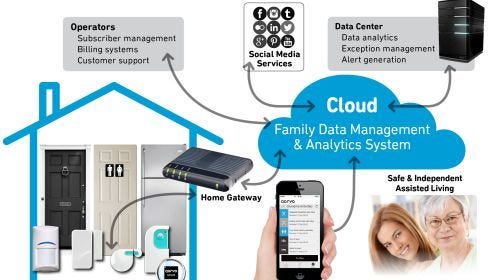How Can IoT Actually Help Consumers? Three Highly Valuable Smart Home Applications
Taking a look at three examples that prove how smart home technology will transform the life of the consumer in the near future.
June 8, 2017

By Cees Links
There is a lot of talk and publicity around the smart home regarding how cool it is, how it will change our lives for the better, how nothing will ever be the same again.
Let us take a look at three exciting smart home applications that go a long way towards proving these claims: Senior Living, Leak Detection, and Lighting Control with “voice”.
Senior living
The Senior Living app provides a secure, yet private way of monitoring seniors in their home as they age. Many seniors prefer to live out their days independently, without having cameras monitoring their daily behaviors or wearing alarm bracelets or necklaces.
Instead, the Senior Living app uses a small network of sensors (as few as four) scattered around the home in strategic locations to monitor the movement of a senior living at home alone. For example, one in the bedroom can track when the senior sleeps. Another tracks when and how often they go into the bathroom, while another in the kitchen can track how often they are eating and preparing food. The fourth sensor is located at the front door and tracks how often and when they leave the house, and how long they leave it for.
These motion sensors feed data to a cloud intelligence system, which over a period of two weeks or so can learn the senior’s daily schedule. When do they normally wake, when and how often do they use the bathroom, when do they prepare and eat their meals, when do they usually leave the home? In addition to providing security for the senior in their home and their family, this data can be useful for medical health monitoring.

The Qorvo Senior and Family Lifestyle system provides next-gen smart home technologies combining a sensor network in the home with cloud intelligence that learns how the home should function and sends an alert when there is a problem.
After the application learns the senior’s activity it can track daily activities and, if there is a sudden change, then send an alert to the family or caregiver. Even more interesting, this system can also track gradual changes in behavior and send alerts if the change could indicate a potential medical issue. Examples are when a senior seems to start walking slowly (balance problems?) or a serious change in how often they go to the bathroom. The four sensors can also tie into other smart sensing applications like heating, lighting, and home security.
Leak Detection
Leak detection sensors for leaky pipes and water heaters have been on the market for years. However, most were limited to sounding an alarm when a leak was detected. A smart leak detection system can not only sense the leak and send out an alert to the home owner, but can also communicate with the home’s water, gas and power systems to reduce water loss, minimize power wastage, and most importantly prevent the extensive damage caused by a water leak that is not recognized and contained quickly.
When a leak is detected, a signal is sent to the home’s (smart) water meter which then turns off the flow of the water. The leak detection app can also communicate with the power meter, turning off the flow of gas and electrical power to the home. As you can imagine, these kinds of leak detection systems are of high interest to utilities as well as to insurance companies who want to get into the smart home market.
Lighting Control
It might not be a life saver, but being able to control the lights and energy usage throughout a home by simply talking to your smart home system can be fun and very effective. Who really wants to get out of their easy chair and check to see if the lights were left on by the kids in the other end of the home?
Remote controlled lighting systems for the smart home have been appearing in the marketplace for the last five years or so. However, it required either using a local remote control or a smart phone to talk to the smart home system that in turn manages the lighting systems.
Lately, various tech companies have been connecting voice systems like Amazon Alexa or Google at Home to these networks, using their cloud intelligence to recognize voice commands to control lighting and energy usage. In these solutions, a person speaks to their device (e.g. a voice enabled remote control), which in turn, via the home’s network, transmits the instructions to the cloud. The cloud intelligence then translates the voice commands into electronic instructions which is then returned to the home’s smart home gateway, and then to the light.
It may seem a long and complicated path but in reality the action is instantaneous, and definitely takes a lot less time than getting up and walking through the home to turn off that darn light. These kinds of voice controls can also be used to control other smart home services like heating and air conditioning, door and window locking, etc.
That’s just three of a whole host of simple examples that will become part of our homes and will change the security, comfort and energy consumption of them — perhaps even creating a new lifestyle that we cannot imagine today. The Internet has changed our lives, and the IoT will definitely take this to the next level!
Alexa, can you feed the dog, please?
Qorvo makes a better world possible by providing innovative RF solutions at the center of connectivity. We combine product and technology leadership, systems-level expertise and global manufacturing scale to quickly solve our customers’ most complex technical challenges.
You May Also Like






